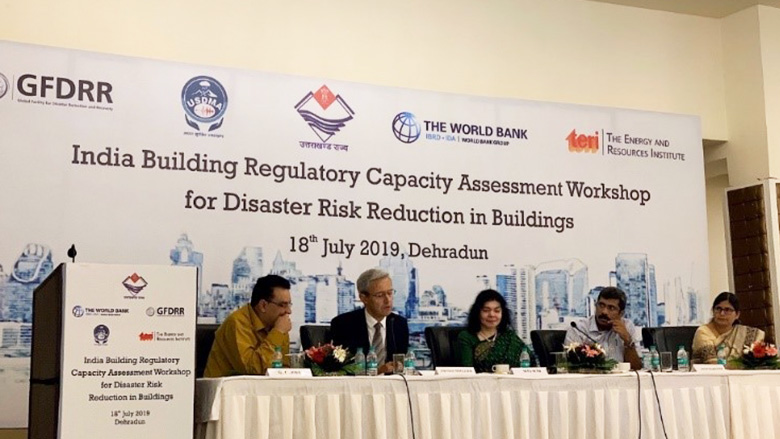July 19, 2019
Dehradun, India
India frequently suffers the harmful consequences of disasters, such as flooding, landslides, and earthquakes, affecting the lives of millions exposed to risk. Vulnerable populations, particularly the urban poor, suffer a high degree of human and economic loss due to disasters, which can be further exacerbated by an unsafe built environment. Experience shows that building collapses, fires, and other recurrent, small-scale events also have destructive impacts, which augment in absence of effective resilient measures. Currently, enforcing robust building regulations is a priority across the country.
The Japan-World Bank Program for Mainstreaming Disaster Risk Management in Developing Countries implemented by the Tokyo Disaster Risk Management (DRM) Hub, is supporting the states of Uttarakhand and Andhra Pradesh, and the Union Territories (UTs) of Jammu & Kashmir and Ladakh in assessing current level of building regulatory capacity and setting up priority actions for further improvements, as outlined in the Building Regulatory Capacity Assessment (BRCA) tool developed by the World Bank’s Building Regulation for Resilience (BRR) Program. The support aims to connect the Japanese knowledge and experience in building regulations with India, drawing lessons on resiliency through regulatory frameworks and capacity building.
On July 18, 2019, in Dehradun, the Uttarakhand State Disaster Management Authority (USDMA), in collaboration with The Energy and Resources Institute (TERI), hosted the "India Building Regulatory Capacity Assessment Workshop for Disaster Risk Reduction in Buildings", inviting officials from Government of Uttarakhand , Disaster Mitigation and Management Center (DMMC), State Disaster Response Force (SDRF), and practitioners from the two states and UTs. The overall objective of the workshop was to share the BRCAs findings on local regulatory frameworks, responsibilities of stakeholders, coordination among stakeholder groups, and implementation mechanisms and exchange views on strategies to translate the assessments’ recommendations into tangible actions.

(Source: World Bank/GFDRR)
Findings and Recommendations of the Workshop
Uttarakhand: Resilience through effective implementation
Uttarakhand is one of the most disaster-prone states in India. While the state has a good understanding of the risks it is exposed to, supported by a study on state wide risk assessment and creation of a disaster risk database undertaken by USDMA, the improvement of building regulations remains a priority challenge. However, the state has attempted to include acts and bylaws in its local legislation that will be a base framework for building code compliance.
For successful implementation of bylaws, technical information or processes that retrofit and update existing regulations can be helpful. This includes, for example, incorporating local hazard maps, implementing structural standards as part of state bylaw, and improving the digital platforms for permitting processes at city and state level.
“Our biggest challenge is compliance. It is urgent that we develop efficient ways to ensure a strict compliance of building bylaws because this is the only way to ensure the safety and security of the community.” -- Amit Singh Negi, Secretary from the Uttarakhand State Disaster Management Authority.
Andhra Pradesh: Towards comprehensive capacity-building
State authorities have made concerted efforts in recent years to strengthen disaster risk reduction, coastal zone regulation, and develop resilient cultural heritage. Other priority areas include improvising procedure systems for building regulations: investing in digital technologies to improve the approval process and streamlining revision steps by technical personnel. For this, skilled and trained staff is required, which is in shortage.
As part of the initiative to enhance the capacity and scope of officials for building regulations, the state aims to create guidelines for eleven different technical profiles (Licenced Technical Personnel) with specific professional requirements. Any long-term capacity-building initiative will require a sustained commitment to provide adequate training opportunities to different professionals, with different focus (fire, accessibility, inspection, etc.), as well as finding qualified staff.
Jammu & Kashmir and Ladakh: Long-term sustainability through innovation
Jammu & Kashmir and Ladakh are exposed to multiple hazards and have a low development index due to the region’s fragile status. Challenges of large-scale events, such as earthquakes, are coupled with chronic hazards like fire, exacerbated by region’s cold weather and difficult access routes. For this, innovative regulatory frameworks need to be developed that consider not only technical matters, but also social and cultural aspects of development, based on principles of accountability and transparency.
Way Forward for Effective Implementation
This workshop laid the ground for follow-up through state-level consultations, leveraging the current political will to build consensus and explore the applicability of the prioritized recommendations. Proactive and innovative communication campaigns, robust risk financing strategies and political support could lead to better development of context-appropriate built environment legislation. These efforts will support the development of action-plans designed to deliver safer and more resilient built environments that could be adopted by other states too.
